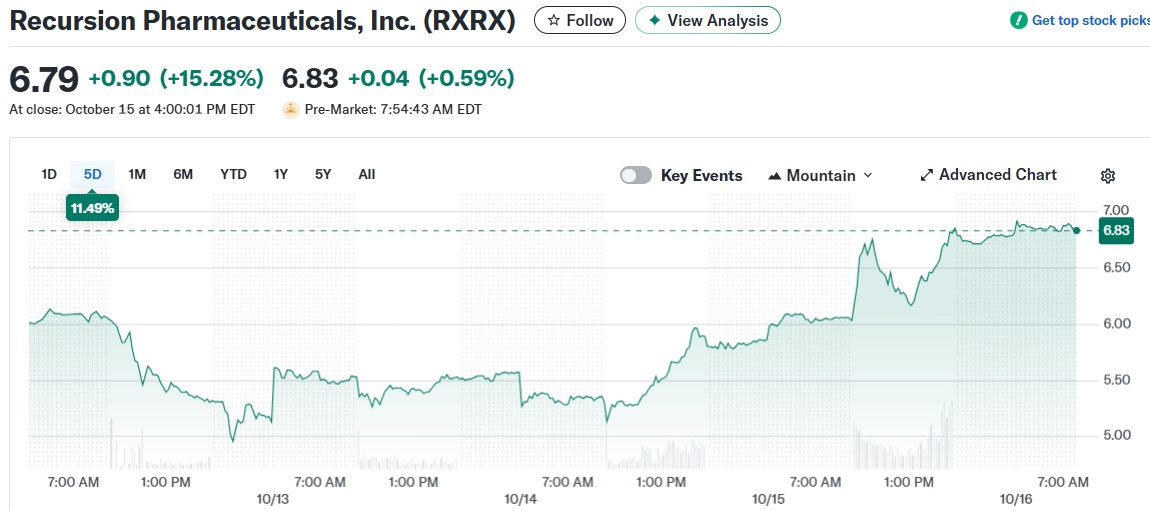TLDR
- Recursion Pharmaceuticals stock jumped 16% on October 8, 2025, reaching around $6.08 after falling 5.4% the previous day on broader market weakness.
- The company reported Q2 2025 revenue of $19.2 million (up 33% year-over-year) but posted a net loss of $171.9 million as R&D spending increased.
- Recursion cut its workforce by 20% in mid-2025 to reduce cash burn, expecting 2025 spending below $450 million and extending its cash runway into late 2027 with $534 million on hand.
- The TechBio firm uses its AI-powered Recursion OS platform to compress drug development timelines, claiming to move candidates from concept to trial in 18 months versus an industry average of 42 months.
- Wall Street analysts maintain a mixed outlook with 2 Buy and 6 Hold ratings, setting an average price target of $6.47, representing roughly 17% upside from current levels.
Recursion Pharmaceuticals experienced extreme volatility in early October 2025. The stock dropped 5.4% to around $5.23 on October 7 during a broader market selloff.

Just 24 hours later, shares rocketed 16% higher to approximately $6.08. The whiplash trading came as investors repositioned ahead of company updates and renewed interest in AI-driven drug discovery.
Trading volume spiked to tens of millions of shares during these swings. The stock settled around $5.89 by October 14, placing it near the middle of its 52-week range of $3.97 to $10.87.
The October surge appears linked to CEO Chris Gibson’s scheduled keynote appearance at an AI technology conference in Dubai on October 15. Investor appetite for the company’s AI story returned after months of bearish sentiment.
Year-to-date, RXRX shares remain down roughly 30% despite the recent bounce. The stock has been a roller coaster for shareholders throughout 2025.
Q2 Results Show Revenue Growth But Mounting Losses
In August 2025, Recursion reported second-quarter financials that highlighted the company’s pre-revenue challenges. Revenue hit $19.2 million, up 33% from $14.4 million in the same quarter last year.
Much of that revenue came from a $7 million milestone payment from partner Sanofi. Without product sales, Recursion relies heavily on partnership payments to generate income.
The revenue growth came with a steep price tag. Net loss for Q2 ballooned to $171.9 million compared to $97.5 million a year earlier.
Research and development expenses jumped as the company invested heavily in its AI platform and clinical trials. Operating a high-tech drug discovery operation requires serious capital.
Recursion ended the quarter with approximately $534 million in cash. That gives the company a runway extending into late 2027, according to management projections.
The Salt Lake City-based biotech expects to burn through less than $450 million in cash during 2025. That’s down from $606 million burned in 2024, thanks to cost-cutting measures.
CEO Chris Gibson said the company needed to “reduce complexity” and ensure every dollar “drives real return on investment.” Translation: Recursion is trimming fat to survive longer without raising more money.
The company implemented a workforce reduction of about 20% in mid-2025. These layoffs aimed to lower operating costs and focus resources on the most promising programs.
Pipeline Pruning and Partnership Strategy
Recursion has made hard choices about its drug pipeline in 2025. The company discontinued several Phase II trials outside its core focus areas of cancer and rare diseases.
Key programs moving forward include REC-617, a CDK7 inhibitor for cancer, and positive preliminary data for REC-4881 in FAP cancer. The company also advanced REC-1245 through development.
In July 2025, Recursion licensed rights to REV-102, an ENPP1 inhibitor for the rare bone disorder hypophosphatasia. This marked an expansion into rare disease treatment.
The company’s technology claims to dramatically speed up drug development. One example showed moving an oncology candidate from concept to clinical trial in 18 months versus a typical 42-month timeline.
Recursion’s Recursion OS platform uses machine learning to analyze millions of cellular images and biochemical experiments. The system searches for new drug candidates at scale.
Big pharma partnerships remain central to the business model. Recursion collaborates with Bayer, Roche/Genentech, Takeda, and Sanofi across multiple disease targets.
These deals provide upfront funding and potential future milestone payments. Partnership inflows have exceeded $130 million to date, supplementing the company’s own development work.
In late 2024, Recursion acquired UK-based AI drug startup Exscientia in an all-stock deal valued at approximately $630 million. The acquisition brought additional AI expertise and pipeline assets under one roof.
Recursion also partnered with NVIDIA to develop AI models. The collaboration produced Boltz-2, an open-source molecular binding prediction model created with MIT.
NVIDIA was an early investor in Recursion. CEO Gibson frequently emphasizes the role of GPUs and AI computing power in the company’s labs.
Wall Street analysts remain divided on Recursion’s prospects. Needham’s Gil Blum reiterated a Buy rating in September 2025 with an $8 price target, citing the company’s leadership position in AI drug discovery.
Morgan Stanley and Bank of America analysts maintained Hold ratings with price targets around $4.80 and $8 respectively. The consensus target sits at approximately $6.50, implying about 35% upside from recent prices.
DirectorStalk tracked 8 analysts covering the stock: 2 Buy ratings and 6 Hold ratings with an average target of $6.47. That represents roughly 17% upside.
CNBC’s Jim Cramer offered a more skeptical view. He said Recursion had “done absolutely nothing” yet and needed to show “proof of concept” before he’d invest.
The bearish take reflects a common concern: Recursion remains pre-revenue with no approved drugs on the market. The company must continue spending heavily to prove its technology actually works.
Financial metrics show the strain. The company posted earnings per share of -1.81 and free cash flow of -$186 million. No dividends are paid as all capital goes back into research and trials.
Recursion’s recent October performance brought the stock back into the spotlight as investors weighed the potential of AI-driven drug discovery against the reality of mounting losses and years until potential product approval.





